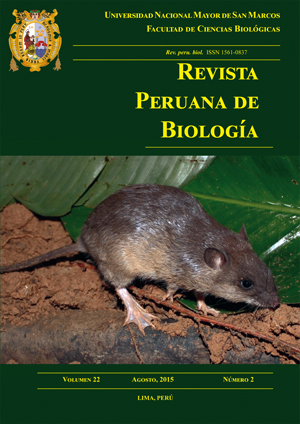Evaluation of the gene encoding the enzyme βHPMEH for the bacterial wilt inhibition caused by Ralstonia solanacearum
DOI:
https://doi.org/10.15381/rpb.v22i2.11353Keywords:
Transient expression, bacterial wilt, quorum sensing, Ralstonia solanacearum, quorum quenching.Abstract
Ralstonia solanacearum is the causal agent of the devastating bacterial wilt disease that attacks important agricultural crops such as potato, tomato, banana, among others, causing serious yield losses. Control of R. solanacearum is difficult because of its wide range of alternate hosts, its long survival in soil, its biological and genetic variation, the lack of natural resistance sources and the insufficiency of the appropriate chemical control measures. Quorum sensing is the term that describes the phenomenon whereby the accumulation of molecules allows bacteria to know the number of bacteria found in the environment (population density). R. solanacearum has a quorum sensing system for the regulation of the expression of virulence genes; the molecule 3-OH-PAME is the self-regulatory signal. The molecule ΒHPMEH hydrolyzes 3-OH-PAME nullifying the signal of virulence, and thus, the quorum sensing communication in R. solanacearum. In order to evaluate the βhpmeh gene we designed two vectors that express this gene under the control of two different promoters. Both vectors were verified by restriction analysis and sequencing. Agroinfiltration assays were used to analyze gene expression and the effect against R. solanacearum in potato (Solanum tuberosum) leaves. The results of the transient expression experiments showed that the expression of gene βhpmeh caused a delay in the appearance of symptoms of bacterial wilt and thus is a good candidate for whole genetic plant transformation.Downloads
Downloads
Published
Issue
Section
License
Copyright (c) 2015 Elizabeth Fernandez, Liliam Gutarra, Jan Kreuze

This work is licensed under a Creative Commons Attribution-NonCommercial-ShareAlike 4.0 International License.
AUTHORS RETAIN THEIR RIGHTS:
a. Authors retain their trade mark rights and patent, and also on any process or procedure described in the article.
b. Authors retain their right to share, copy, distribute, perform and publicly communicate their article (eg, to place their article in an institutional repository or publish it in a book), with an acknowledgment of its initial publication in the Revista Peruana de Biologia.
c. Authors retain theirs right to make a subsequent publication of their work, to use the article or any part thereof (eg a compilation of his papers, lecture notes, thesis, or a book), always indicating its initial publication in the Revista Peruana de Biologia (the originator of the work, journal, volume, number and date).


















